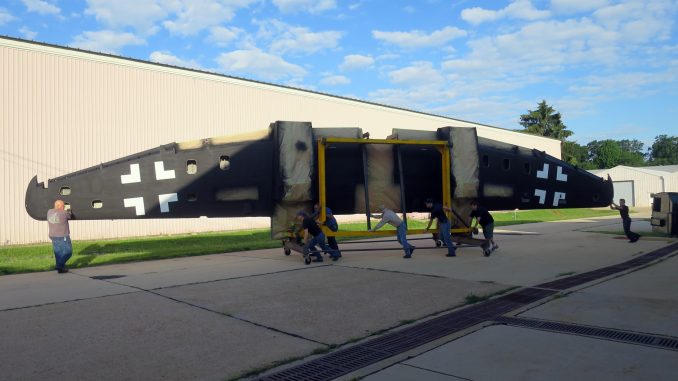
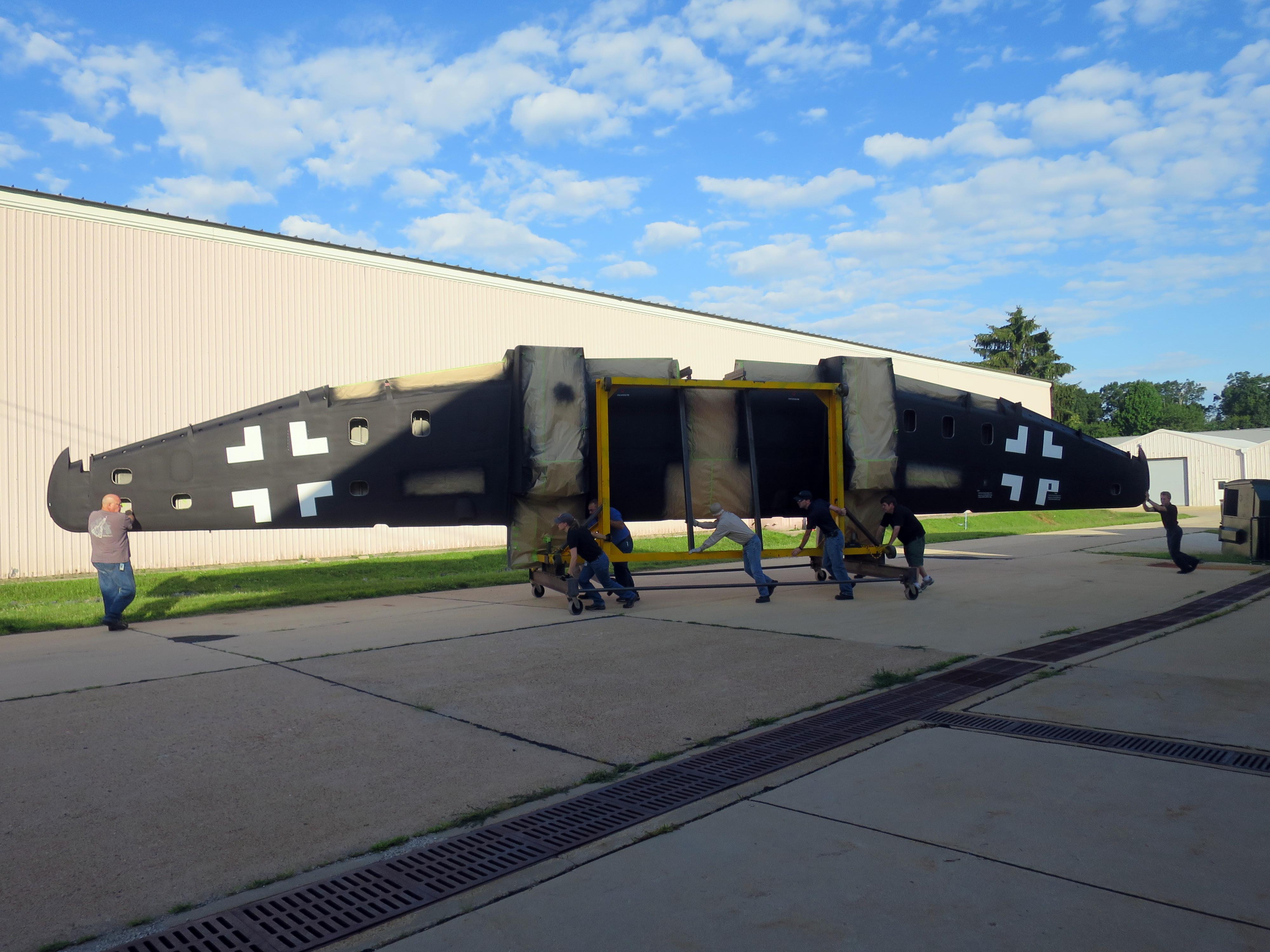
WarbirdsNews has some exciting news coming from the Smithsonian’s National Air & Space Museum, and some fantastic photographs to share with much thanks to NASM’s press officers. The restoration crew at the Paul E. Garber Restoration Facility in Silver Hill, Maryland has finished their work repairing the wings for the museum’s unique Heinkel He-219 A-2 Uhu, Wk.Nr.290202. In mid-July, the team prepared the freshly repainted wings for shipment to the Udvar-Hazy Center in Chantilly, Virginia. For the first time in years, they took the long-hidden 63′ span airfoil outside, mounted to its massive custom steel frame, and rotated the whole assembly 90 degrees, until it lay in a more natural, horizontal configuration. It is now more or less ready for loading onto a flat-bed truck for the forty mile journey to its final home.
The Heinkel He-219 was the only German aircraft from WWII built specifically from the ground up as a night fighter. The Northrop P-61 Black Widow was the only other dedicated night fighter to serve in WWII. Interestingly, the He-219 was the first aircraft to come with a steerable nose wheel, and had the world’s first operational ejector seats. It’s principal armament consisted of a set of cannon mounted in the aft fuselage which fired obliquely in an upwards direction. The aircraft would fly into the RAF bomber streams at night, guided by its radar, and then sneak up under the wings of a usually unsuspecting aircraft. It would then unleash the fury of its guns at near point-blank range, with almost universally fatal results for the stricken warplane and her crew. This weapons system, known to the Germans as “Schräge Musik” (Jazz Music), was extremely effective, and it was not unheard of for a He-219 or other similarly equipped Luftwaffe night fighter with an expert crew to shoot down a dozen or so Allied bombers in one evening, such was their lethality.
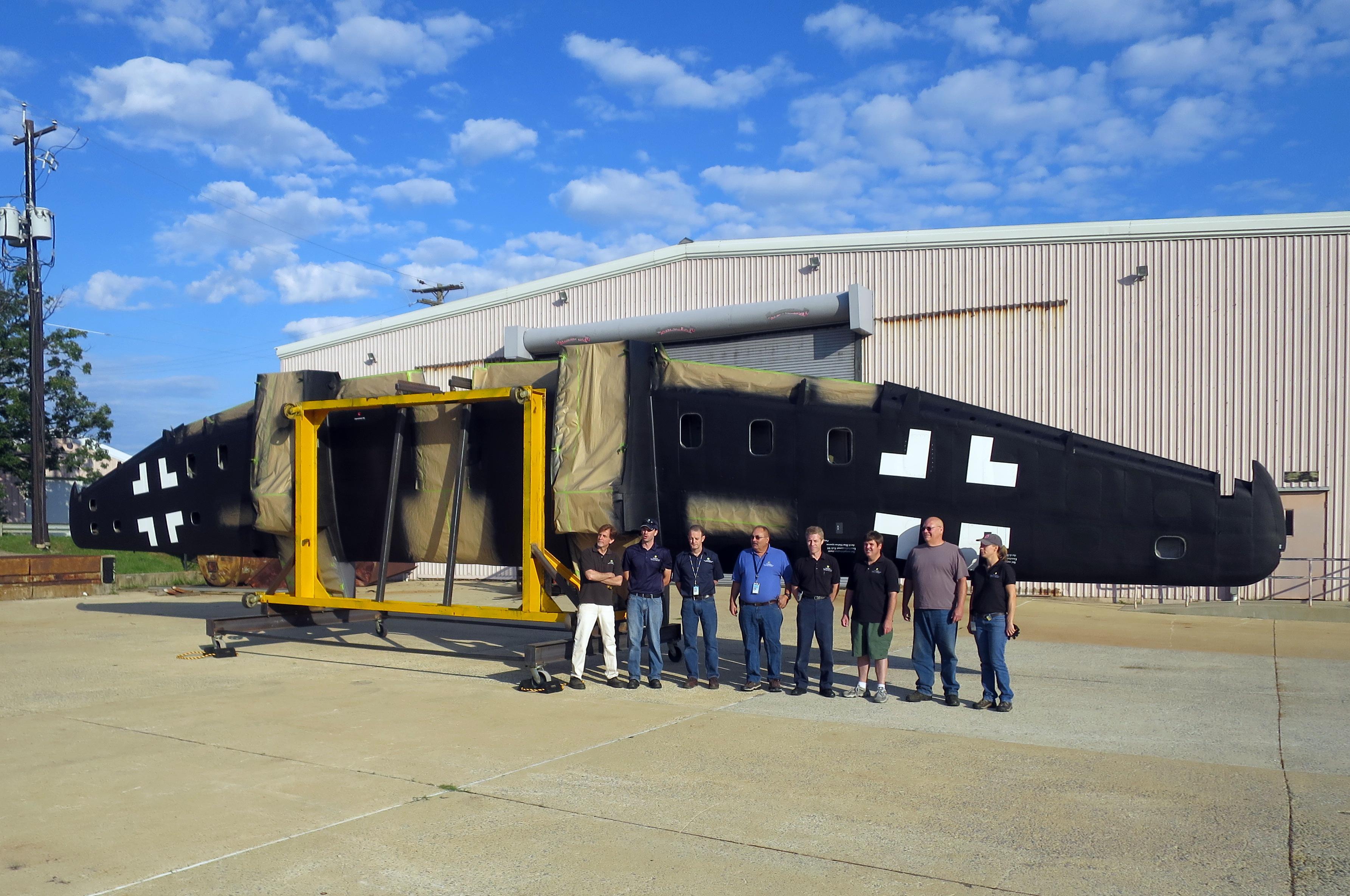
NASM’s He-219 belonged originally to Nachtjagdgeschwader 1 in Jutland, Denmark. A special US Army Air Force unit known as “Watson’s Whizzers” took possession of her shortly after the war ended in Europe, and flew the fighter to Cherbourg, France. Here she boarded the British carrier HMS Reaper alongside twenty other captured Axis aircraft. The ship brought its precious cargo to the USA for evaluation. Wk.Nr.290202 ended up at Freeman Field in Indiana, bearing the foreign equipment number FE-614, which eventually changed to T2-614. Testing lasted into 1946, after which the He-219 ended up in storage at Park Ridge, Illinois. Eventually, the Smithsonian acquired the ‘219, and boxed her up as components for shipment to their facilities in the Washington, DC area. She sat quietly gathering dust until about ten years ago, when the restoration process began.
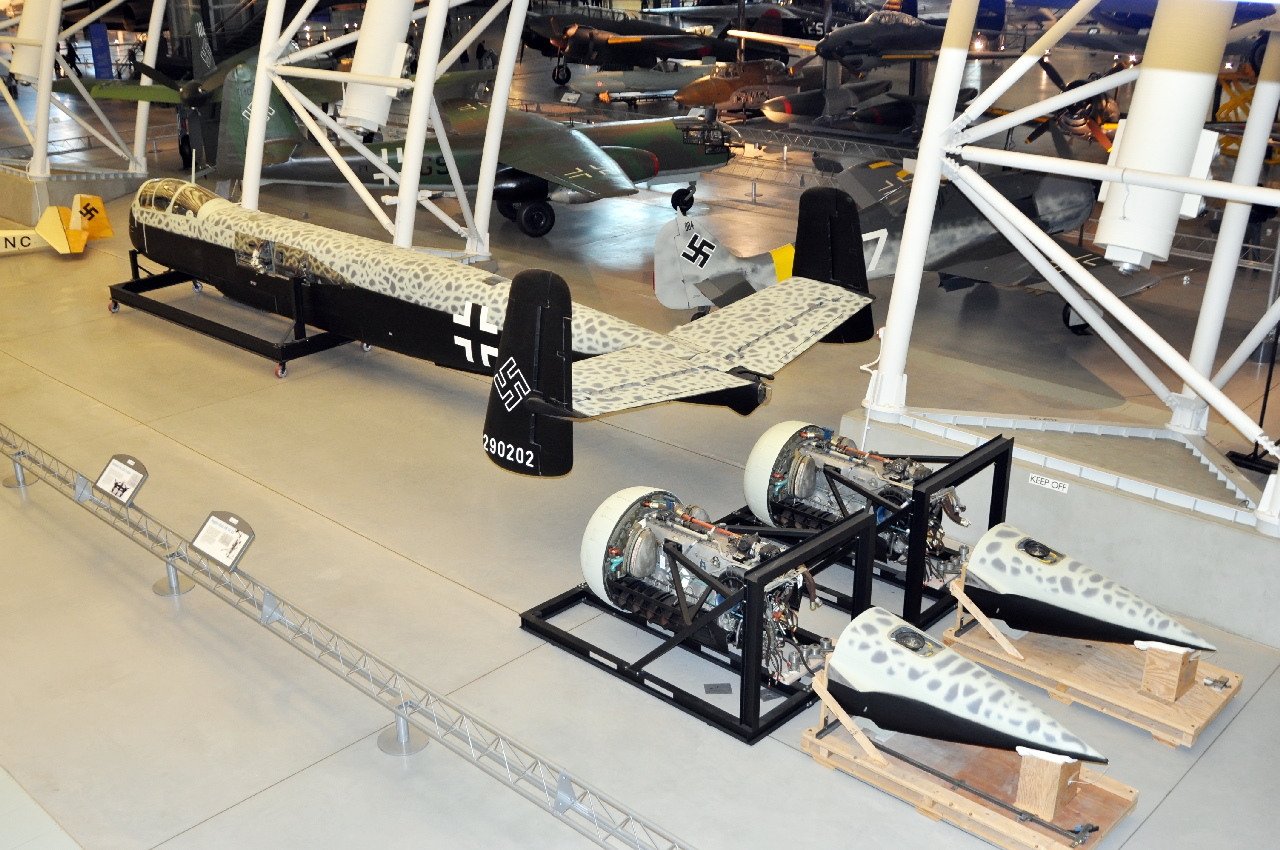
The ultra-rare, German night-fighter’s fuselage and engines are already complete, and have been on display at the Udvar-Hazy Center for some years now (see above). The wings will soon join them at Udvar-Hazy, but will first go into the Mary Baker Engen Restoration Hangar to receive their final layer of green/blue Wellenmuster (wave pattern) camouflage. The airframe’s final assembly will take place later this year, and then the Heinkel will go on show to the public for the first time since just after WWII.
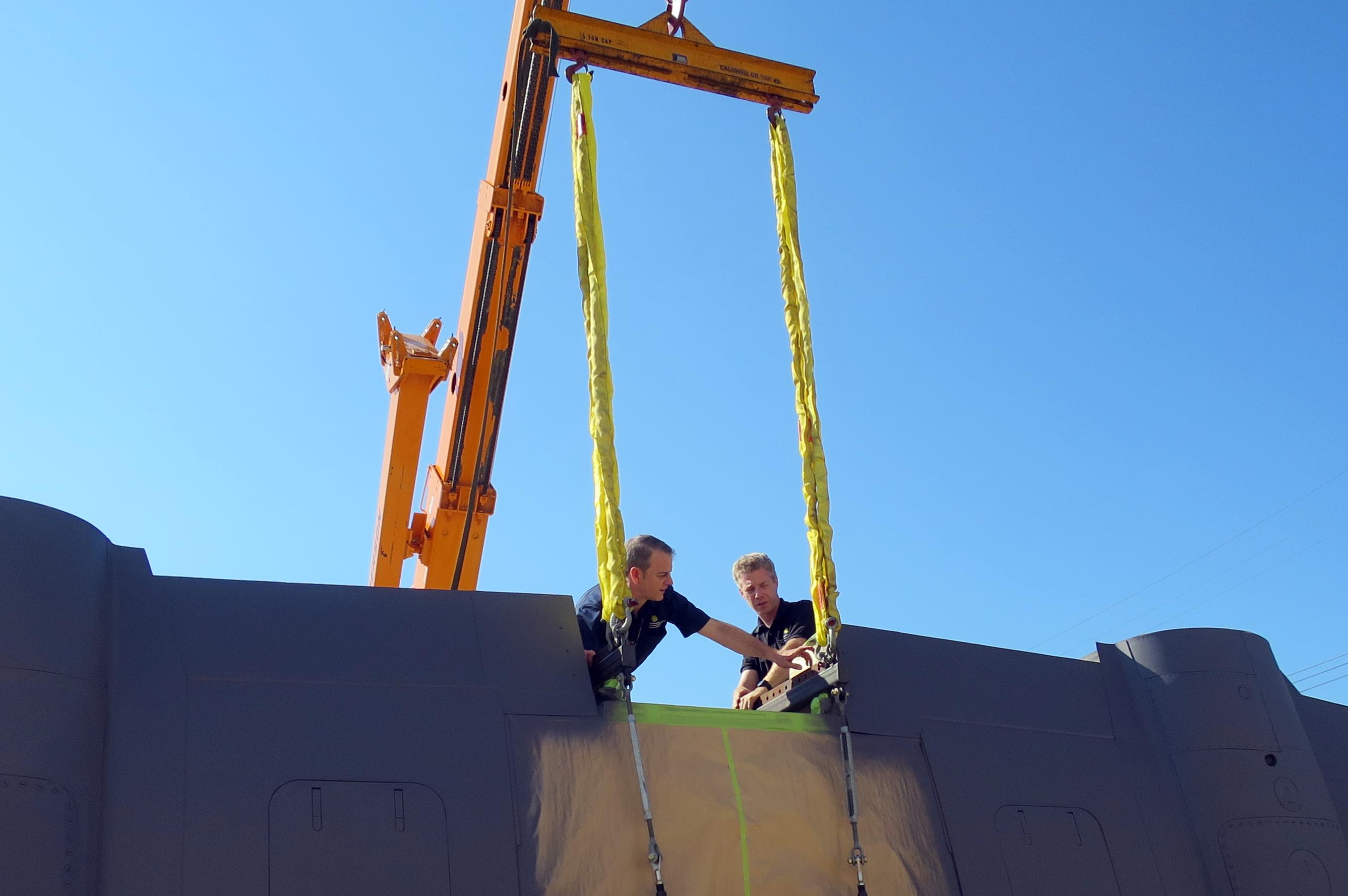
Rotating the nearly 5,000lb He-219 wings on their roughly 1,000lb maintenance stand took a dozen or so museum workers three hours to shift from its vertical position, to horizontal. The wings had been mounted vertically to more easily facilitate painting.
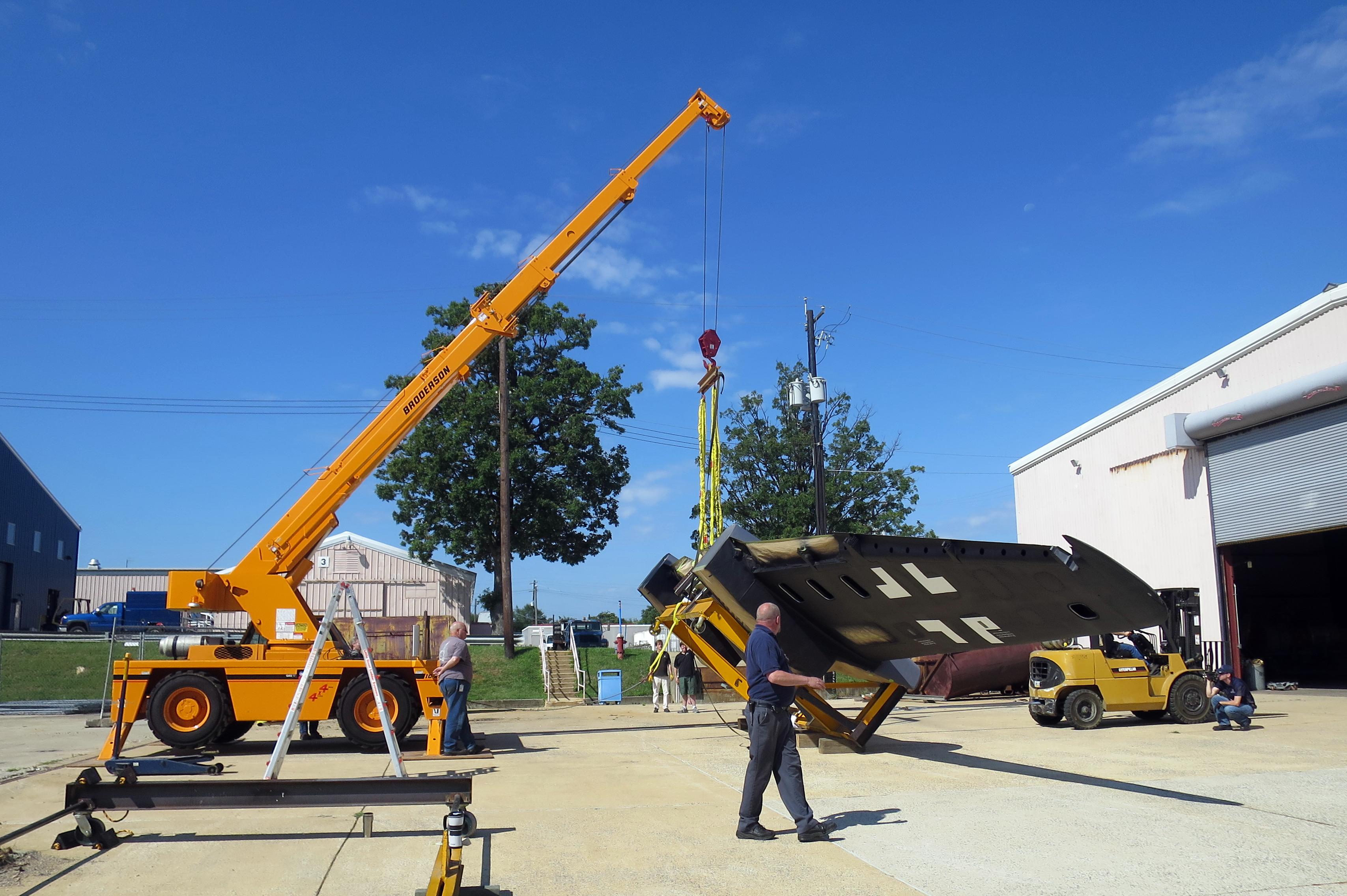
Only one major item remains missing, the set of nose-mounted FuG 220 radar antennae. The radar array became separated from the airframe, probably before she arrived in NASM’s care. The museum has managed to locate an original FuG 220 antenna array in Europe, and secured their loan allow NASM’s world-class restoration team to reverse engineer a newly manufactured replica.
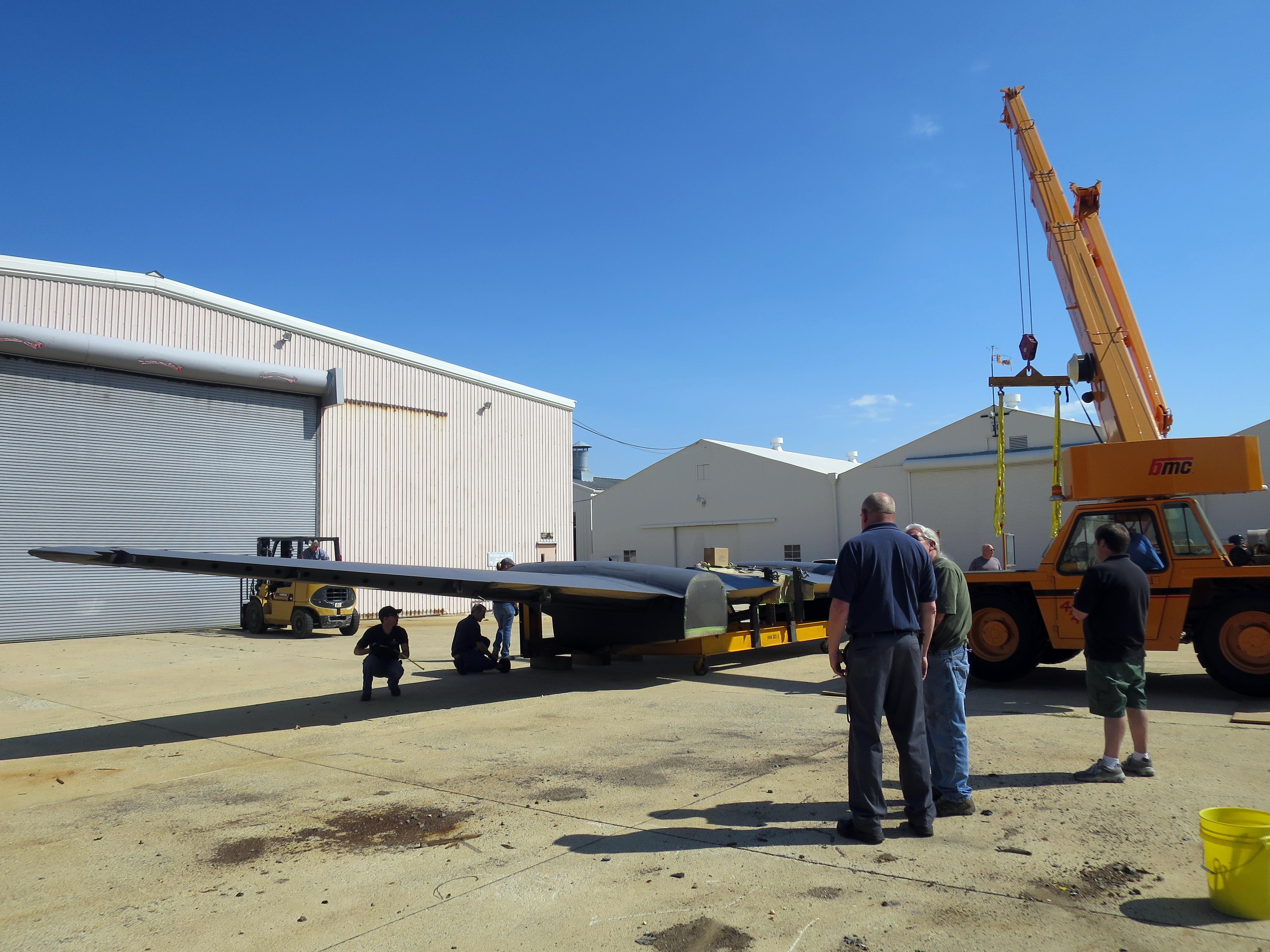
Only one other substantially complete He-219 survives in preservation. A team of divers raised this example in pieces from off the Danish coast a couple of years ago. You can see from the photograph below that it is in pretty ragged shape. The aircraft is currently undergoing preservation at a museum in Jutland. You can see further photographs from that recovery, as well as some more recent restoration images HERE.
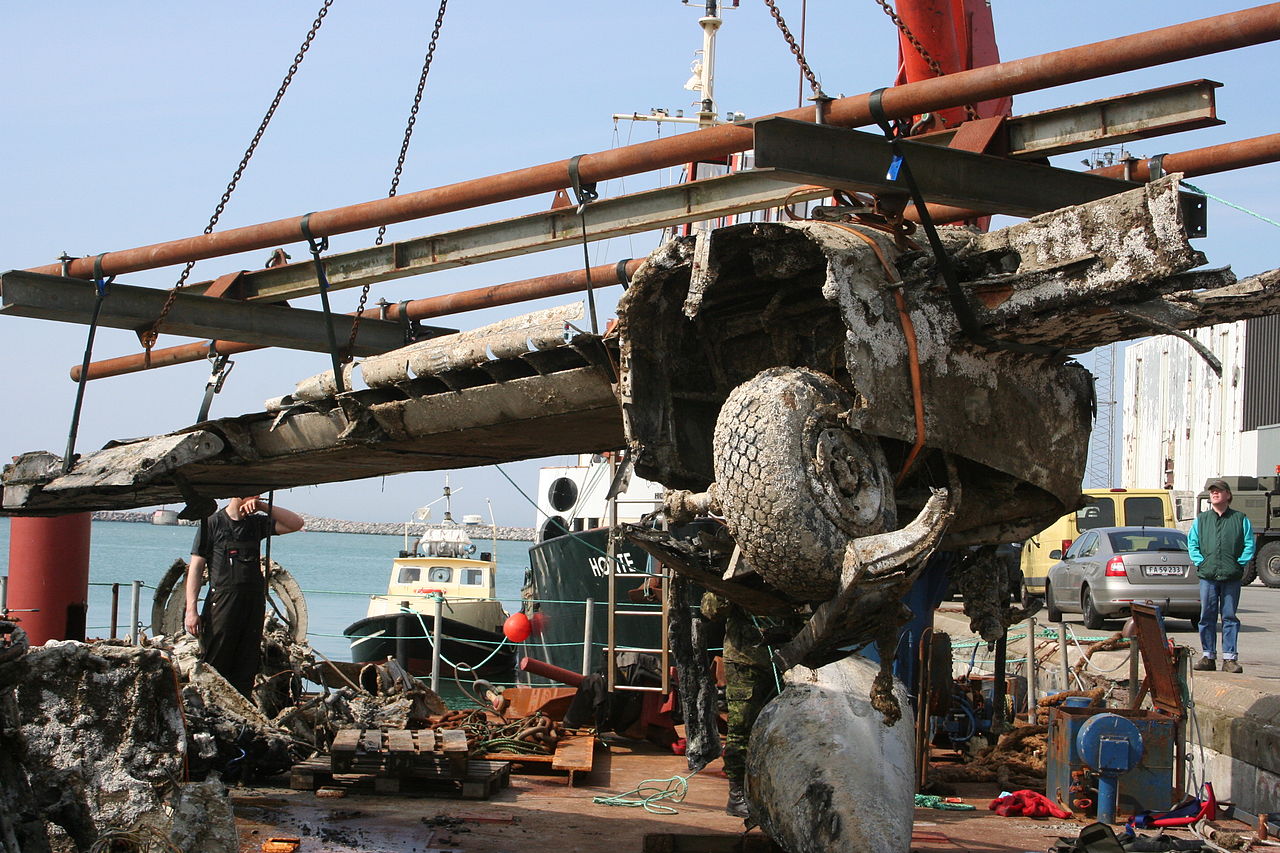
Related Articles
Richard Mallory Allnutt's aviation passion ignited at the 1974 Farnborough Airshow. Raised in 1970s Britain, he was immersed in WWII aviation lore. Moving to Washington DC, he frequented the Smithsonian’s National Air & Space Museum, meeting aviation legends.
After grad school, Richard worked for Lockheed-Martin but stayed devoted to aviation, volunteering at museums and honing his photography skills. In 2013, he became the founding editor of Warbirds News, now Vintage Aviation News. With around 800 articles written, he focuses on supporting grassroots aviation groups.
Richard values the connections made in the aviation community and is proud to help grow Vintage Aviation News.


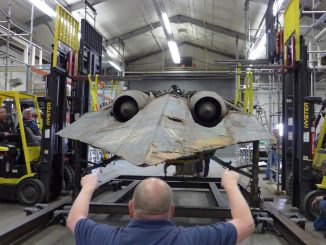
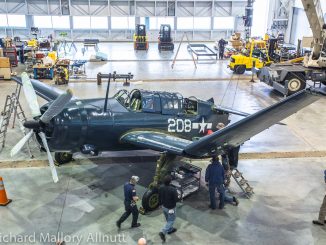
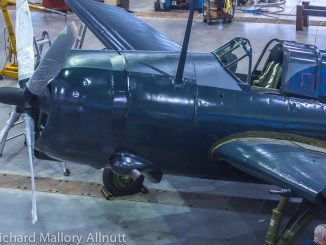

Yes, the Schräge Musik you mention was an important element in the offensive armament of this type. But it could also be mentioned that the short production run of He 219, comprising several sub-types, was provided a variety of prey-stunning fixed forward armament too. In addition to the 30mm Schräge Musik installation, cannon were also mounted in the wingroots (total two) plus more in an under-belly pack (two or four) in various combinations of 20mm and 30mm weapons.
Production of the type was arbitrarily halted by officialdom against the wishes of the Luftwaffe, but service use was extended by six machines assembled from available parts by operational units. These ‘special’ aircraft operated minus serial numbers and so did not appear in official Luftwaffe records.
“Production of the type was arbitrarily halted by officialdom against the wishes of the Luftwaffe..”
This statement is nonsense. Erhard Milch favored a newer version of the Ju 88/188, since the development and introduction of new types like the He 219 disrupted production schedules. So he eventually cancelled it. Milch was procurement head of the Luftwaffe, Goering’s deputy.
The HE-219 may have been the first German operational aircraft to have a steerable nose wheel, but the P-38 beat it by many years. The P-39 also.
Nonetheless, I’ve been in awe of this bird at NASM Udvar-Hazy Center. Will be great to see it complete!
The P-38 and P-39’s nose wheel were both free castering. Steering was done with differential braking and power. See http://p38whitelightnin.com/story/Ladd_Interview/index3.html
“The only other dedicated night fighter was the previous P-61 black widow” I’m sorry but have u ever heard of the De Havilland mosquito, yes that’s right it escorted RAF night bombers and outmatched any other German night fighter.
Sorry spell check not previous black widow *p 61 black widow.
Still its just more US propaganda
There was indeed a de Havilland Mosquito night fighter variant, and very successful it was too, but the type was not a “dedicated night fighter” like the P-61 Black Widow, which only served in that role (during WWII).
I’m pretty sure the mosquitoes could fly night operations doing reconnaissance missions or harrasing night fighters with radar. I think it was in Norway a me 410 was destroyed by a mossie patrolling in the area. What it doesn’t say here is that the heinkel 219 actually shot down 6 mosquitoes however when I read of heinkel 219s being lost, a majority were lost to mossies
Hello
Actually, 10 Mosquito’s were shot down by He219’s of the I./NJG 1, at least one Mosquito crashlanded in the UK after having been badly shot up by another pilot of the I./NJG 1 in Venlo. This German claim was not officially acknowledged by the Luftwaffe claim commission.
You are correct in that the Mossie did in fact fulfill the night fighter role but that is not what it was initially designed to do. The Air Ministry’s design requirements that lead to the Mossie’s creation were for a fast medium bomber. The design was so effective, however, that it later became a multi-role combat aircraft.
The Mossie was never designed to be a dedicated night fighter like the Uhu and Widow. It just turned out that it could do practically everything 😀
Im afraid the De Havilland Mosquito was initially designed as a high speed bomber than a dedicated night fighter such as the He-219 ( and the Ta-154 “Moskito” too).
Sorry Alex, but the Mosquito was a High Speed Bomber. The HE219 was designed & built as a High Speed “Nachtjahdflugzeug” to catch & shoot down the Mosquito & larger bombers which it did amazingly.
Hello,
Can someone describe how the nose wheel could be steered by the pilot of a He219 ? I haven’t found any steering wheel or device yet.
Best regards, Marcel / Venlo
The nose wheel was controlled by a linkage through the rudder pedals, IIRC.
There were some multi-role spinoffs of the He-219 that were never produced. As a night fighter though it excelled in its intended role as a heavy bomber destroyer.
Many people seem to miss the fact that in context, night fighting was not “dogfighting”. Intercepts were accomplished using radar, and whether it was a ‘219 on the tail of a Mosquito or visa versa one had no real advantage over the other. If tail radar warned a pilot early enough it could take evasive action but in crowded airspace aerial collisions were a real possibility and occasional reality.
The reason most ‘219s were lost to Mosquito’s was a matter of numbers, there were not many other allied night fighters that had the range to operate in, or were used in the areas 219s were.
I do hope that one day I will be able to see this rare warbird.
ummmm What of the Beaufighter????
The beaufighter was, like the others named, not produced originally as a night fighter. The P-61 and the 219 were designed from the start as night fighters, as opposed to others which were designed for other roles, but adapted to use as night fighters. Hence, use of the term “dedicated night fighters”. The Beaufighter was originally designed to be a heavy fighter–not a night fighter. Also, it was a derivative of the earlier Beaufort, which was a torpedo bomber.
Any way you look at it, NASM’s efforts to bring this important piece of history back for all to study and appreciate is beyond amazing … Well Done!!
..these a/c did NOT down up to 12 bombers in one night. Ridiculous statement. The ‘biggest’ night time loss was 9 in March 1945 (Becker/Johannsen